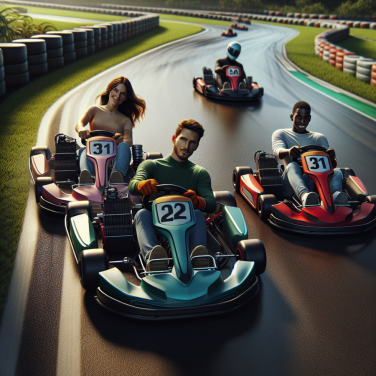Understanding the Basics of Speedway Racing
Speedway racing stands as a unique motor sport, distinguished by its emphasis on sliding motorcycles around an oval track composed of dirt or loosely packed shale. Originating as early as the 1920s, this exhilarating form of racing has captivated audiences with its blend of high-speed competition and skilful precision from riders.
At the core of speedway racing lies its bikes, which are finely tuned machines built with a singular purpose: to race in tight circuits with no brakes. That's right, these lightweight yet powerful bikes are designed without brake systems, which means racers must rely on their skills to control their speed and navigate the corners through careful balance, throttle management, and tactical sliding, also known as broadsiding or drifting.
Each race, commonly referred to as a "heat," usually involves four riders competing over four laps. The simplicity of speedway track design, typically a flat oval with two straights and two bends, belies the complexity of the techniques riders must employ to achieve victory. Riders hurtle into bends and pitch their bikes sideways into a slide, using the throttle to control their speed and trajectory around the track. The delicate art of controlling a brakeless bike means that anticipation and reflexes are king, with riders developing an intimate understanding of both their machines and the track's surface.
The racing format is straightforward, often featuring a series of heats where riders accumulate points, leading to semi-finals and a final heat to determine the victor of the event. Speedway races are short, sharp, and packed with action, meaning fans are treated to an adrenaline-fueled spectacle that is both accessible and thrilling.
Speedway isn't a solitary affair, though. Riders are typically part of a team, and team strategy can play an essential role in the outcome of a meeting. Coordinating maneuvers and considering opponent capabilities are all part of what makes a team successful in speedway racing.
Tracks for speedway racing vary, but they are often about 260 to 425 meters in length. The surfaces can influence the style of racing, with different materials offering varying levels of grip. Maintaining the track and understanding its characteristics play a crucial role in the setup of a rider's bike.
From the strong smell of methanol fuel and the buzz of roaring engines to the spectacular sight of bikes drifting in unison around a banked turn, the sensory experience of speedway racing is unmatched.
Read also:
Melbourne's Top 3 Thrilling Go-Kart Tracks for Speed Lovers
Understanding the Basic Concepts of Speedway Racing
Speedway racing is an exhilarating motorsport that revolves around oval tracks, where riders or drivers compete at high speeds. Unlike other forms of racing, speedway tracks are generally shorter and more enclosed, which makes for exciting and fast-paced events.
Types of Speedway Vehicles
There are several types of vehicles used in speedway racing, each providing a different experience:
1. Motorcycles: One of the most popular forms of speedway racing involves motorcycles. These bikes are specially designed with no brakes and a fixed gear, which requires a unique riding style that emphasizes sliding through the turns.
2. Stock Cars: These closed-wheel cars are often associated with NASCAR and are built to endure long races and contact with other vehicles.
3. Sprint Cars: Recognizable by their large wings and powerful engines, these open-wheeled cars are designed for short, high-speed races.
Speedway Tracks and Surfaces
The racing surface of a speedway track is a significant factor that affects the racing conditions. Tracks can be made of dirt, clay, or asphalt, with each surface offering different levels of grip and requiring different racing techniques. Dirt and clay tracks, in particular, often lead to more sliding around the corners, compared to the more predictable asphalt surfaces.
Race Format and Scoring
Speedway races can vary in format, but they usually consist of heats, semi-finals, and a final. Points are awarded based on finishing positions in each heat, which determine the competitors who advance to the next stage. The racer with the most points at the end of the final is declared the winner.
Safety Measures
Despite the thrill, speedway racing comes with risks. To ensure the safety of competitors, strict safety standards are implemented. These include wearing protective gear such as helmets, fire-resistant suits, and gloves. In addition, speedway bikes are equipped with cut-off switches, and tracks feature barrier systems to protect riders and spectators.
Getting Involved in Speedway Racing
For those interested in becoming a part of the speedway community, attending local races is a great start. You can also enroll in racing schools or academies that provide training and insights into the sport. For a more hands-off approach, fans can join fan clubs, participate in online forums, or volunteer at events to get closer to the action.
The Thrill of the Race Day
On a race day, the atmosphere at a speedway track is electric.
Navigating the Speedway Scene: Essential Tips for New Fans
Navigating the speedway scene can seem daunting for newcomers, but with a few essential tips, you'll soon find your bearings and enjoy the exhilarating world of racing to its fullest. As part of Speedway 101, let's dive into what you need to know to become a savvy speedway fan.
**Understanding the Classes and Formats**: Speedway races vary widely in terms of vehicle classes, from stock cars to sprint cars and midgets. Familiarize yourself with the different types - each has unique characteristics and rules. Also, get to know the various formats of races, like heats, features, and time trials, so you can follow the action comprehensively.
**Gear Up Appropriately**: Comfort is key for a long day at the races. Wear comfortable shoes for walking on uneven terrain and bring layers to adjust to changing weather conditions. Don't forget ear protection, as the roar of the engines can be deafening, especially for young children or sensitive ears. Sunglasses, hats, and sunscreen are also a must on sunny days.
**Learn the Lingo**: Like any sport, speedway racing has its own language. Terms like "slide job," "cushion," and "dirty air" describe specific maneuvers or racing conditions. Boost your enjoyment and understanding of the event by learning the jargon used by announcers and seasoned fans.
**Know the Track**: Each track has its own personality and quirks. Spend some time studying the layout and surface type, as these can significantly influence race strategies. Track size ranges from short tracks to super-speedways, affecting the competition's pace and style.
**Respect the Race Protocol**: Be aware of the flag signals during a race. The green flag starts the race, yellow signals caution, red means stop, and checkered flags signify the end of the race. Understanding what each flag means will help you follow the officials' instructions and enhance your viewing experience.
**Connect with the Community**: One of the best aspects of speedway racing is the community. Don't be afraid to strike up conversations with fellow fans. Not only will this enrich your experience, but seasoned enthusiasts are often eager to share their knowledge and insights with newcomers.
**Get to Know the Drivers**: Learn about the drivers' backgrounds, their teams, and their career statistics. This will give you a greater appreciation for their skills and the drama of the competition. Plus, having a favorite driver or team can make the races even more exciting to watch.




